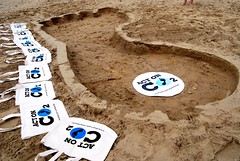 Tar Sands Collage - Wikipediaby Robert Mellinger, Yes! magazine: http://www.yesmagazine.org
Tar Sands Collage - Wikipediaby Robert Mellinger, Yes! magazine: http://www.yesmagazine.orgTar sands imports to the EU could be banned altogether after the EU Commission on Climate Change backed new greenhouse gas (GHG) emissions standards as part of the Fuel Quality Directive first adopted in 2009.
Pursuant to the directive’s original goal of a 6 percent reduction of CO2 emissions from transport fuel production by 2020, the new standards set values for each fuel based on estimated grams of CO2 released per megajoule of energy produced.
They set a much higher emissions value for tar sands oil than conventional oil production, making oil produced in Canada's controversial sands an unviable option if the directive’s goals are to be achieved. [1]
Although tar sands oil is not a major import to the EU, the move reveals a sharp contrast between international business interests and environmental realities, and would set a precedent for future bans on other controversial fuels—including shale gas, whose extraction process is known as fracking.
EU member states will vote in just a few weeks on the directive, which could be blocked by two nations that have expressed opposition: the UK and the Netherlands.
Britain’s Under Secretary for the Department of Transport, Norman Baker, said in a September 26 letter that he would oppose the inclusion of the tar sands in the directive, The Guardian reported.
Incidentally, the UK recently began drilling for domestic shale gas reserves, which could also be threatened if the emissions standards are eventually extended to non-transport fuels.
To read more, go to: http://www.yesmagazine.org/planet/eu-considers-ban-on-tar-sands-oil?utm_source=wkly20111028&utm_medium=yesemail&utm_campaign=titleMellinger






